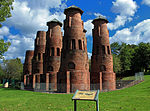The Lehigh Valley (), known colloquially as The Valley, is a geographic and metropolitan region formed by the Lehigh River in Lehigh and Northampton Counties in eastern Pennsylvania. It is a component valley of the Great Appalachian Valley bounded to its north by Blue Mountain, to its south by South Mountain, to its west by Lebanon Valley, and to its east by the Delaware River and Warren County, New Jersey. The Valley is about 40 miles (64 km) long and 20 miles (32 km) wide. The Lehigh Valley's largest city is Allentown, the third-largest city in Pennsylvania and the county seat of Lehigh County, with a population of 125,845 residents as of the 2020 census.The Allentown–Bethlehem–Easton metropolitan area, which includes the Lehigh Valley, is currently Pennsylvania's third-most populous metropolitan area after those of Philadelphia and Pittsburgh, and the nation's 68th-largest metropolitan area with a population of 861,889 residents as of 2020. Lehigh County is among Pennsylvania's fastest-growing counties, and the Lehigh Valley leads Pennsylvania in terms of population growth in the 18- to 34-year old demographic, which constitutes a significant portion of the labor workforce. The region's core population centers are located in southern and central Lehigh and Northampton counties along Interstate 78, Interstate 476, Pennsylvania Route 309, and U.S. Route 22.
The Lehigh Valley has historically been a global leader in steel and other heavy manufacturing industries, which represented a considerable portion of its employment and economic production for most of the 20th century. Beginning in the early 1980s, however, the region's heavy manufacturing sector experienced a rapid downfall, highlighted by the downsizing and ultimate closure of Bethlehem Steel, once the world's second-largest steel manufacturer, and other Valley-based manufacturing companies. The Valley's economy struggled considerably before ultimately rebounding and since emerging in the 21st century as one of Pennsylvania's largest and fastest-growing economies. As of 2021, the Lehigh Valley's gross domestic product (GDP) is $50.960 billion, driven by diverse industry sector contributions from its finance, manufacturing, health care and education, and information sectors. In the 21st century, the region also has emerged as a national center for the U.S. logistics industry, especially in warehousing and intermodal transport.The region's primary commercial airport is Lehigh Valley International Airport in Hanover Township; the airport's air traffic has grown considerably in the 21st century, largely as a result of considerable growth in its commercial air cargo traffic, which exceeded 210 million pounds in 2016.The Lehigh Valley is located within the U.S. Northeast megalopolis with ease of access and close proximity to many of the nation's largest population centers, airports, terminals, railways, and seaports, including New York City, the nation's largest city, which is 90 miles (140 km) to its east, and Philadelphia, the nation's sixth-most populous city, which is 60 miles (97 km) to its southeast. The region is located geographically within a one-day drive to over a third of the U.S. population and over half of Canada's population, which has been a factor in its 21st century emergence as a North American leader in light manufacturing and commercial distribution. Gains in these and other industries have helped offset the significant losses the region had experienced from its late 20th century decline in heavy manufacturing.
Since its settlement in the 1700s, the Lehigh Valley has been the birthplace or home to several notable Americans who have proven influential across a broad range of fields, including academia, art and music, business, government and politics, the military, professional and Olympic-level athletics, and other fields.








